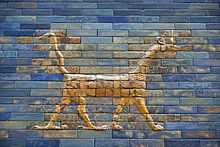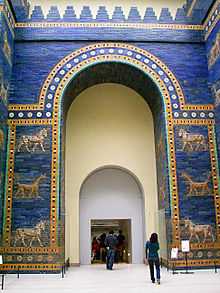Mušḫuššu
 Sirrush bas-relief in the Pergamon Museum. | |
| Grouping | mythological hybrid |
|---|---|
| Sub grouping | Dragon |
| Similar creatures | Hydra |
| Mythology | Babylonian mythology |
| Other name(s) | Sirrush |
| Region | Mesopotamia |
The mušḫuššu (𒈲𒄭𒄊; formerly also read as sirrušu, sirrush) is a creature depicted on the reconstructed Ishtar Gate of the city of Babylon, dating to the 6th century B.C. As depicted, it is a mythological hybrid: a scaly dragon with hind legs resembling the talons of an eagle, feline forelegs, a long neck and tail, a horned head, a snake-like tongue, and a crest.
The form mušḫuššu is the Akkadian nominative of the Sumerian 𒈲𒄭𒄊 MUŠ.ḪUS, lit. "reddish snake" sometimes also translated as "fierce snake".[1] One author,[2] possibly following others, translates it as "splendor serpent" (𒈲 MUŠ is the Sumerian term for "serpent". The reading sir-ruššu is due to a mistransliteration in early Assyriology.[3]).
History

The mušḫuššu is the sacred animal of Marduk and his son Nabi during the Neo-Babylonian Empire. It was taken over by Marduk from Tishpak, the local god of Eshnunna.[4]
The constellation Hydra was known in Babylonian astronomical texts as 𒀯 𒀭 𒈲 MUL.dMUŠ, “the serpent (with divine and star determinatives)”. It was depicted as a snake drawn out long with the forepaws of a lion, no hind-legs, with wings, and with a head comparable to the mušḫuššu dragon. [5][6] This monstrous serpent may have inspired the Lernaean Hydra of Greek mythology and ultimately the modern Hydra constellation.
Bel and the Dragon, a deuterocanonical Biblical text, relates a story that Koldewey thought involved a mušḫuššu/sirrush. In a temple dedicated to Bel (Nebuchadnezzar's god), priests had a "great dragon or serpent, which they of Babylon worshipped."
Daniel, the protagonist of the Book of Daniel, was confronted with this creature by the priests in the apocryphal text. (see Additions to Daniel) They challenged him to match his invisible God against their living god. Eventually, Daniel poisoned the creature.
Cryptozoology
German archeologist Robert Koldewey, who discovered the Ishtar Gate in 1902, seriously considered the notion that the sirrush was a portrayal of a real animal. He argued that its depiction in Babylonian art was consistent over many centuries, while those of mythological creatures changed, sometimes drastically, over the years. He also noted that the sirrush is shown on the Ishtar Gate alongside real animals, the lion and the rimi (aurochs), leading him to speculate the sirrush was a creature the Babylonians were familiar with. The creature's distinctly feline front paws seemed incongruous, and gave Koldewey some doubt. However, in 1918, he proposed that Iguanodon (a dinosaur with birdlike hindfeet) was the closest match to the sirrush (Sjögren, 1980).
Cryptozoological speculation regarding the sirrush was also presented by Adrienne Mayor and Bernard Heuvelmans.[7]
Willy Ley, in Exotic Zoology, speculated that it might depict a Sivatherium. Another theory is that it is a creature unknown to zoology, inhabiting the marshes of southern Iraq.[2]
See also
- Hydra (constellation)
- Ningishzida
- The Beast (Bible)
References
- ↑ "The Electronic Text Corpus of Sumerian Literature". Etcsl.orinst.ox.ac.uk. 2006-12-19. Retrieved 2014-08-25.
- ↑ 2.0 2.1 Costello, Peter (1974). In Search of Lake Monsters.
- ↑ The Assyrian Dictionary, vol. 10 part II, p. 270.
- ↑ P. Bienkowski, Alan Ralph Millard, Dictionary of the Ancient Near East. University of Pennsylvania Press, 2000. p. 189
- ↑ F.A.M. Wiggerman,Snake Gods”
- ↑ E. Weidner, Gestirn-Darstellungen auf Babylonischen Tontafeln (1967) Plates IX-X
- ↑ Mysterious creatures: a guide to cryptozoology, Volume 1, George M. Eberhart, ABC-CLIO, 2002, p. 2003
Bibliography
- Jerome Clark (1993). Unexplained! 347 Strange Sightings, Incredible Occurrences, and Puzzling Physical Phenomena. Detroit: Visible Ink Press.
- Bernard Heuvelmans (1958). On The Track Of Unknown Animals. New York: Hill and Wang.
- Willy Ley (1959). Exotic Zoology. New York: Viking Press.
- Karl Shuker (1995). In Search of Prehistoric Survivors. London: Blandford. ISBN 0-7137-2469-2
- Bengt Sjögren (1980). Berömda vidunder, Settern ISBN 91-7586-023-6 (Swedish)
External links
| Wikimedia Commons has media related to Mushussu. |
- Mushrushu (or Sirrush) artwork from Ishtar Gate & lore
- The Ishtar Gate
- The Cryptid Zoo: Sirrush in Cryptozoology